I Am the Warp, You are the Weft:
An Interview with Eric-Paul Riege
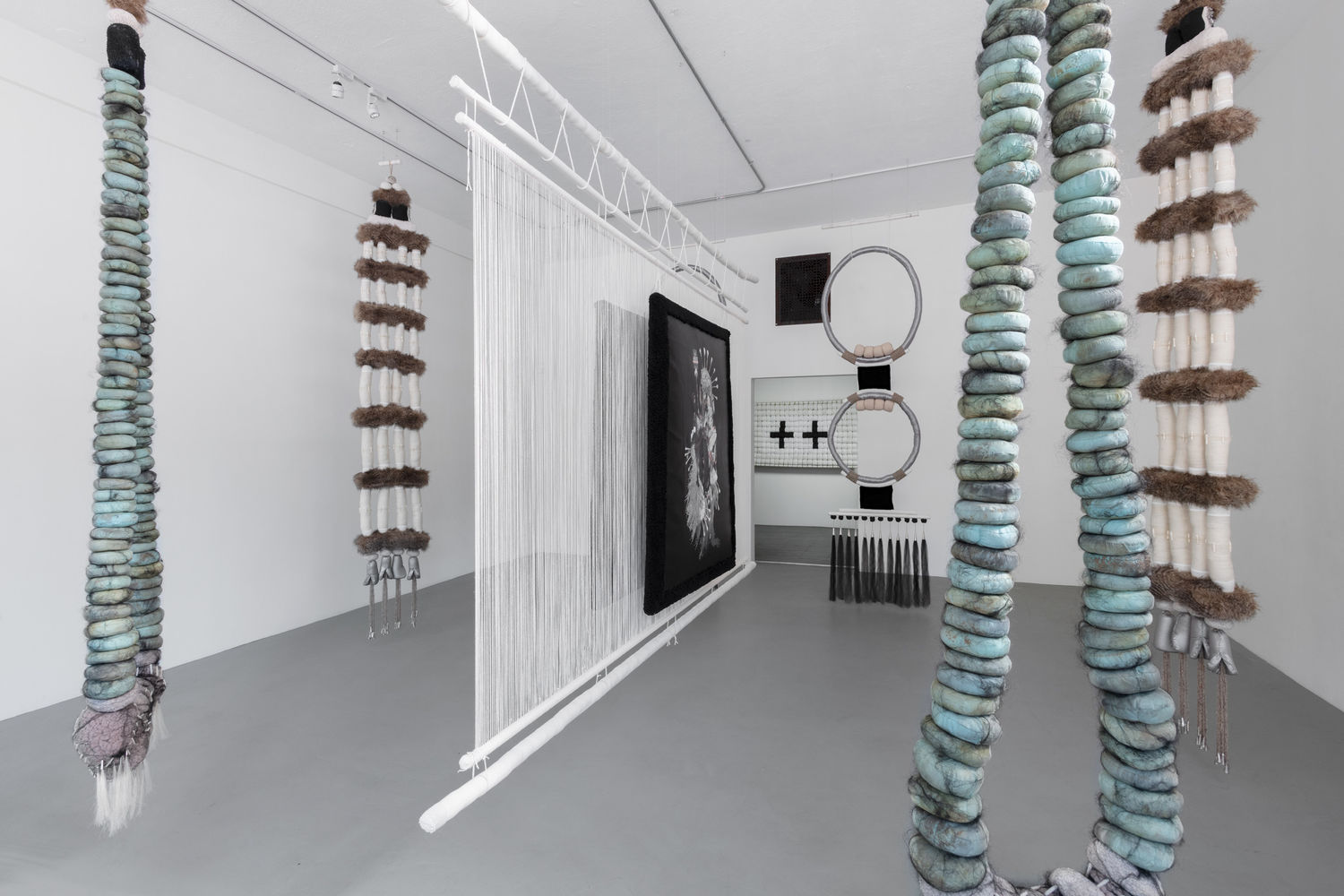
“I consider everything I do a weaving,” says Diné artist Eric-Paul Riege. “Talking to you, I consider myself the weft and you the warp, and as we’re talking the threads of our lives, our histories, and our futures become intertwined and braided and tangled.” Based in Na’nízhoozhí (Gallup, New Mexico), Riege uses weavings, often animated through performance, to tell hybrid tales that interlace stories from Diné spirituality with his own personal interpretations and cosmology. Soft and welcoming, his sculptural installations use natural and synthetic materials, from hand-dyed sheep’s wool to his own hair, leather and cat fur to artificial cashmere and polyester. As Riege opens the three-person show Now You See It, Now You Don’t (with Natalie Ball and Grace Rosario Perkins), we revisit an interview conducted in conjunction with his 2021 Bockley Gallery exhibition, (my god, YE’ii [1-2]) (jaatłoh4Ye’iitsoh [1–6]) (a loom between Me+U, dah ‘iistł’ǫ́).
PSHow do you introduce yourself in terms of your background, your medium, your heritage and culture?
EPRI’ve always been comfortable with just the terms artist and weaver. In terms of my heritage, I’m a Diné artist.
PSYou’ve also referenced the Charcoal Streaked Division of the Red Running Into the River clan and talked about your parents and your grandparents.
EPRThose are my clans. Those are the way we introduce ourselves to Diné people and how we are related and how our families or regions are connected. It’s always been important for me to have that as a foundation of who I am, where I’m coming from, and my voice. My family is such an important thread within the fibers of my work that when I’m traveling or presenting my work or performing, they’re always there with me.
PS“The fibers of your work.” It’s such a fitting phrase.
EPRI consider everything I do a weaving. Talking to you, I consider myself the weft and you the warp, and as we’re talking the threads of our lives, our histories, and our futures become intertwined and braided and tangled. When I’m performing I consider myself one partner and the warp being the other partner. All my performances are called weaving dances, so we’re dancing and braiding our bodies together. I come from a background of weavers and fiber artists on both sides of my family.
PSYour maternal great-grandmother was a Diné weaver?
EPRShe’s this figure in my family that I got to know as a child. She passed in 2006, and I believe she was 104 when she passed. She was an amazing weaver, and I’m blessed to have been gifted some of her weavings. She is at the root of everything I do—in my life, in my art career, and even in the ways that I think and speak.
PS Did you learn to weave at home through her, or did you study it in school?
EPRThis is always a funny question for me because I don’t know. I have this specific memory of weaving as a child, a small pink-and-brown piece, but my parents don’t remember this, and that weaving doesn’t exist anywhere. But it’s so prevalent within my brain that I don’t know if it was a dream that I made reality or if it was reality and that weaving just got lost somewhere. Recently I started thinking maybe that was a premonition of the future. Some sort of final weaving. Maybe I had this dream about the last weaving I’ll ever do, and it’ll be this little weaving.
I have always been around fiber and yarn. As a kid I really liked yarn and soft materials. Braiding became an early tool, and I played with dolls a lot. I’d braid their hair. I guess that’s an early form of weaving for me. But the first time I took a traditional Navajo weaving class I was 18 or 19. It was my first year of college, and that’s when I really learned technique and craft.

photo-sculpture, inkjet print, mixed fiber frame
53 x 41 x 4 inches
When I introduced myself to the loom and started having these conversations with the yarns, my hands were ten steps ahead of my brain and they figured out what they were doing before my brain did. It was a beautiful experience getting to learn the loom in that way.
PSThe words that come to mind when you say that are channeling or embodiment or intuition or even cellular memory. It feels like somehow this form or metaphor or skill is ingrained in you, is woven into you.
EPR It’s a beautiful thing to realize as I grow as an artist. Submitting to the power of my hands is really important for me and really special. My hands are my favorite part of the body. If I want to learn about a work, it’s really important for me to perform with it. To weave my body and hear a lot of the sounds and the weight of it and the way it gets tangled upon itself or even my body. Some of the fringe gets tangled between my toes and then I can’t walk, or I’m wearing it on my head and I can’t see. I have to rely on other senses to move through a space.
I’ve made a decision as an artist that everything I do has to be worn or carried or thrown, stepped on, rolled in. Whatever the work wants to do with me and gifts me, that’s what I learn about it.
Yet sometimes after a performance I know just as much as the audience does. Everyone’s interpretation of what just happened is equally as important and valid as mine. We all got to experience it together.
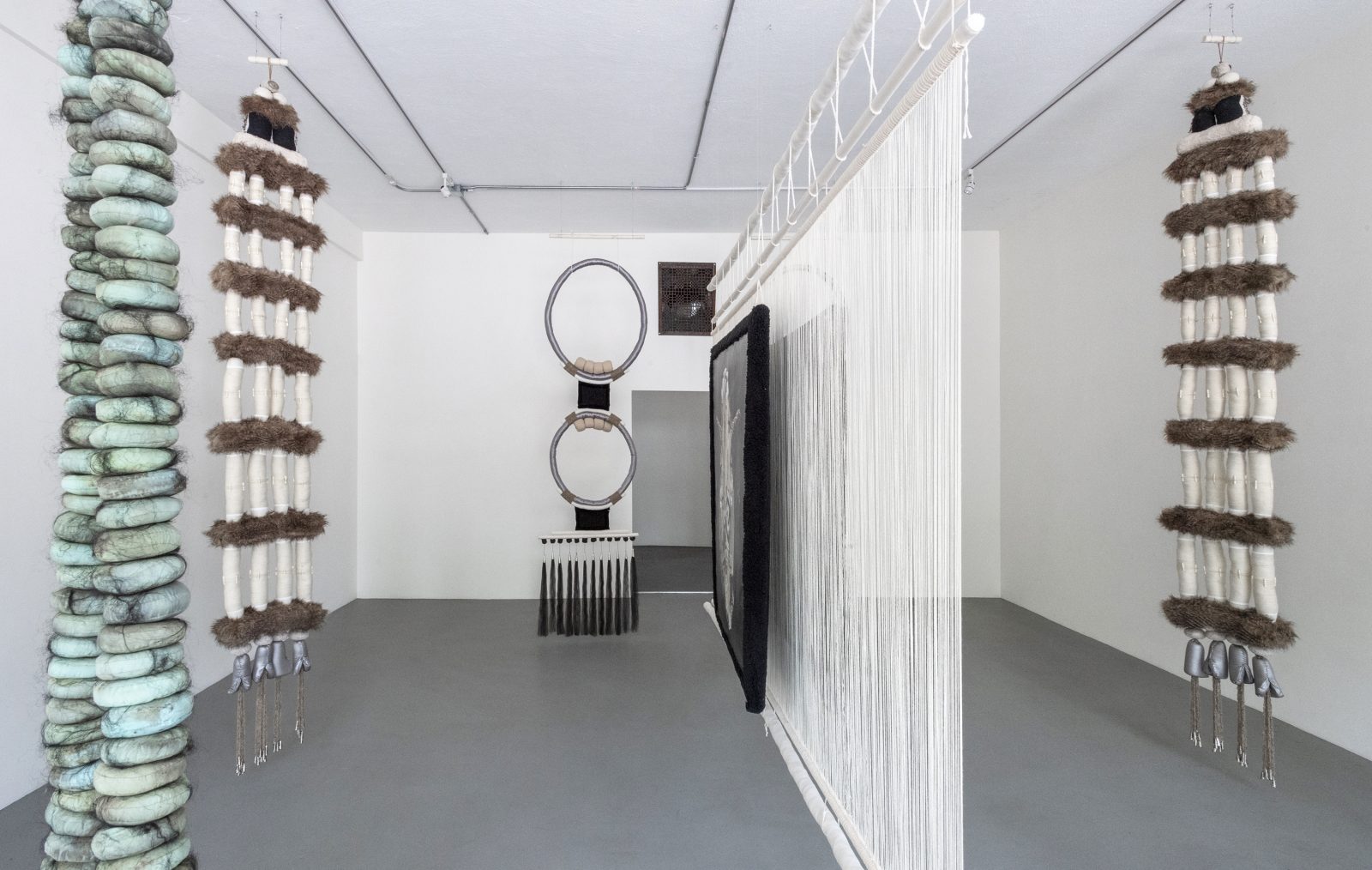
PSTell me about the title of the project here at Bockley Gallery.
EPR It’s made up of the titles of the three pieces that are in the show. Oftentimes I think of the titles of the pieces as their names. I consider a lot of what I do as living because as I change, they change. They’re never really static or finished. For this exhibition I wanted to reference that and give respect to how this is the name of all the pieces.
The title is (my god, YE’ii [1-2], (jaatłoh4Ye’iitsoh [1–6]) and (a loom between Me+U, dah ‘iistł’ǫ́). In the first two, YE’ii is a term for god but then also a holy figure. Jaatłoh4Ye’iitsoh, which is the next title, means “the earring for a big god.” In one of our holy stories, there are monsters that are traveling around the world, and I wanted to create earrings for these giant gods, because according to one of the stories that has been shared with me, one way that our holy people recognize us is through our jewelry and turquoise and our squash-blossom necklace. This is how our ancestors and those we consider our holy people recognize us and protect us.
But jewelry is also a way to hold memories. One day when I was younger, I was told by my grandmother that as we navigate the world our earrings and necklaces—and I’ve extended this further to clothes—are listening, just as much as we are. If you’re having a conversation with somebody and perhaps forget a certain part of that conversation, your earring remembers, so when you take that earring off and put it back on the next day, those memories are still in that earring and that knowledge is still there. These large soft-sculpture earrings are totems of not only my memory but then the collective memory of artists, the collective memory of my past, present, and future self.
Then the last piece is called (a loom between Me+U, dah ‘iistł’ǫ́); “dah ‘iistł’ǫ́” is the Diné word for loom. One translation that I love of that word is “from the ground up it grows.” As you’re weaving, it’s growing up from the ground. When a weaving is on the loom it’s considered a living object. And I’ve extended that idea by introducing everything I do as living. There’s a respect between yourself and the weaving as it’s growing. It’s a living object so you have to tend to it, care for it, protect it, mend it. a loom between Me+U, dah ‘iistł’ǫ́ is a reference to this. It’s a 9- or 10-foot tall loom that I made two years ago. I wanted to bring it here to Minnesota to show me as an outsider to this place, but also to be thankful for the invitation to be here by having a loom between me and you. There’s this border between myself and the place, but at the same time this border is one that’s living, that’s ever-growing. You can see through it, there’s energy that lives through it. It’s a border that’s sacred.
PSI’m guessing that the idea of “inanimate” objects isn’t one that resonates for you.
EPRI don’t consider anything inanimate, and that’s something I’ve had to deal with my whole life. Even a shirt that I’m selling or giving to a thrift store, I almost consider everything as having a little brain, little eyes, a little face. I’m overly attached to objects, I’m a materialist in the true sense of the word, where everything I do has a little brain or a little heart. This is a very childhood-like thing that I’ve held onto. I’ve become a hoarder with materials, with mementos, with gifts. Even notes that I would pass in high school and middle school, I still have those.
PSThey’re like charged objects for you.
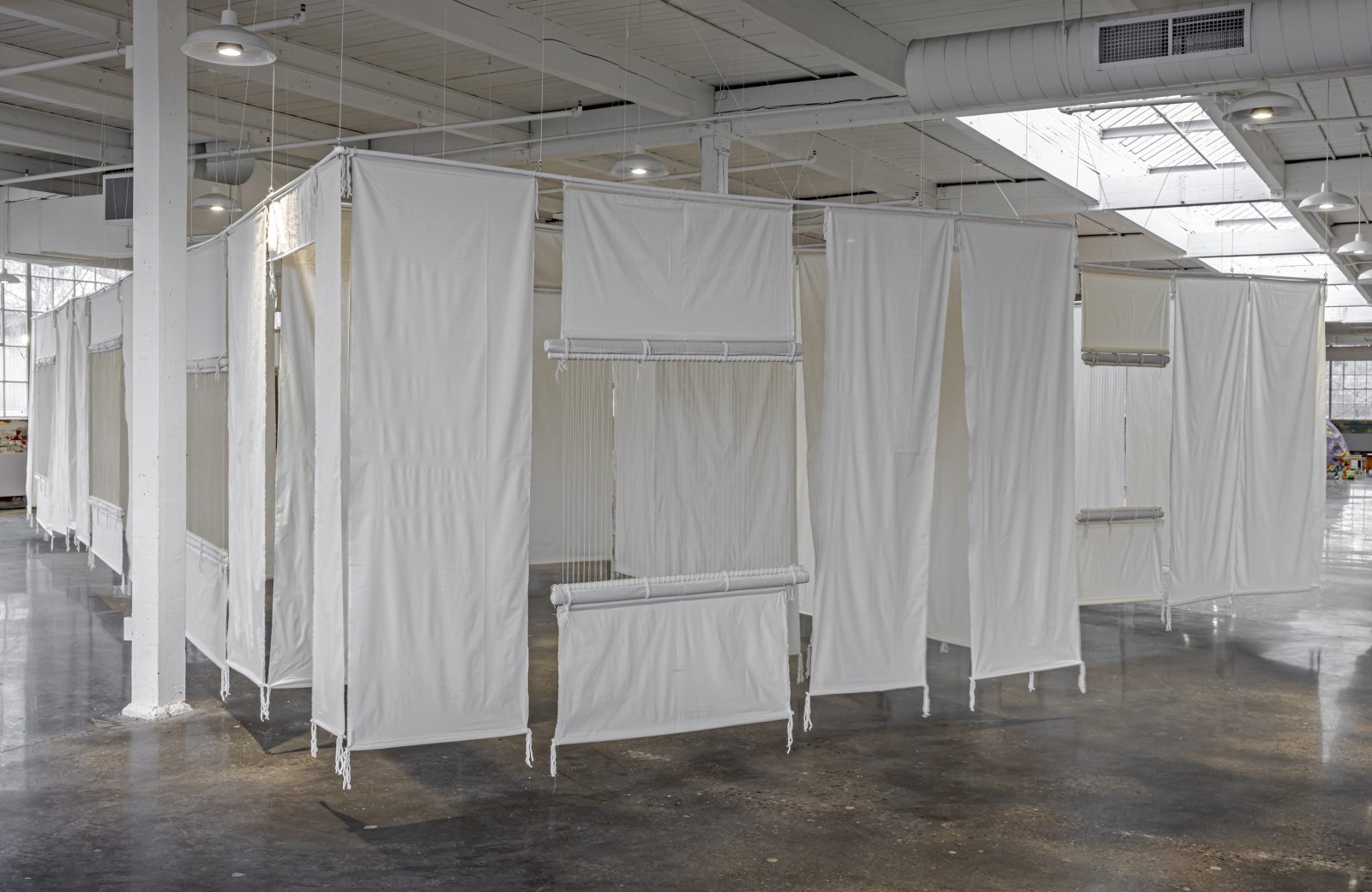
mixed fibers
photo by Toni Hafkenscheid
commissioned by the Toronto Biennial of Art
EPR There’s life in each object that I’ve been gifted, and I think about the history of where this wood came from or the sheep whose fibers I’m gifted. I think about every element that goes into the creation of objects and how they’ve all been presented to me. I’m flooded with history in so many ways, and not only in my life and my home; all of that goes directly into the work. There are so many histories that live within each weaving or each fiber of what I do.
PS Does that play into what you said earlier about your work never being finished? If these objects are indeed animate, why lock them into one form for all of eternity and have it be finished?
EPR Totally. Oftentimes after an exhibition I will disassemble my work and then reassemble it into new forms, new shapes, new sculptures. I consider it a vital part of my practice that I make and then unmake and then remake and then unmake again. A lot of the work I have now has existed in different forms throughout the past five or six years, going back to when I first began considering my practice as a career.
It’s fun seeing things grow over time. As I grow, they grow; as I scar, they scar. This is also something, too: speaking about some of these metaphors, like my Diné cosmologies, when I’m talking about my work, I’m not just speaking about sacred stories that have been passed down to me but also my own interpretations of what those are as a means to keep our sacred stories to ourselves.
It’s almost like I’ve been creating my own religion or my own gods through my work. I’ve made the joke before: it’s like I’m both the cult leader and the cult follower of my own work. I’ve definitely been crafting my own belief system and my own spirituality. I reference a lot of Catholic words like baptism or stigmata. I had this performance with a friend where I cut the inside of my palm during the performance and had to end up going to the emergency room. For me it was a stigmata of my work—the work piercing me and having this shared blood magic happen between us. I never saw the inside of my hand before. I only cut the skin; I luckily didn’t cut any nerves or muscle, but I could see when I was rinsing my hand the fat on the inside of my hand. It was super intense.
PSI love what you’re saying about how you incorporate your personal knowledge as well as your cultural and spiritual ones that you inherited.
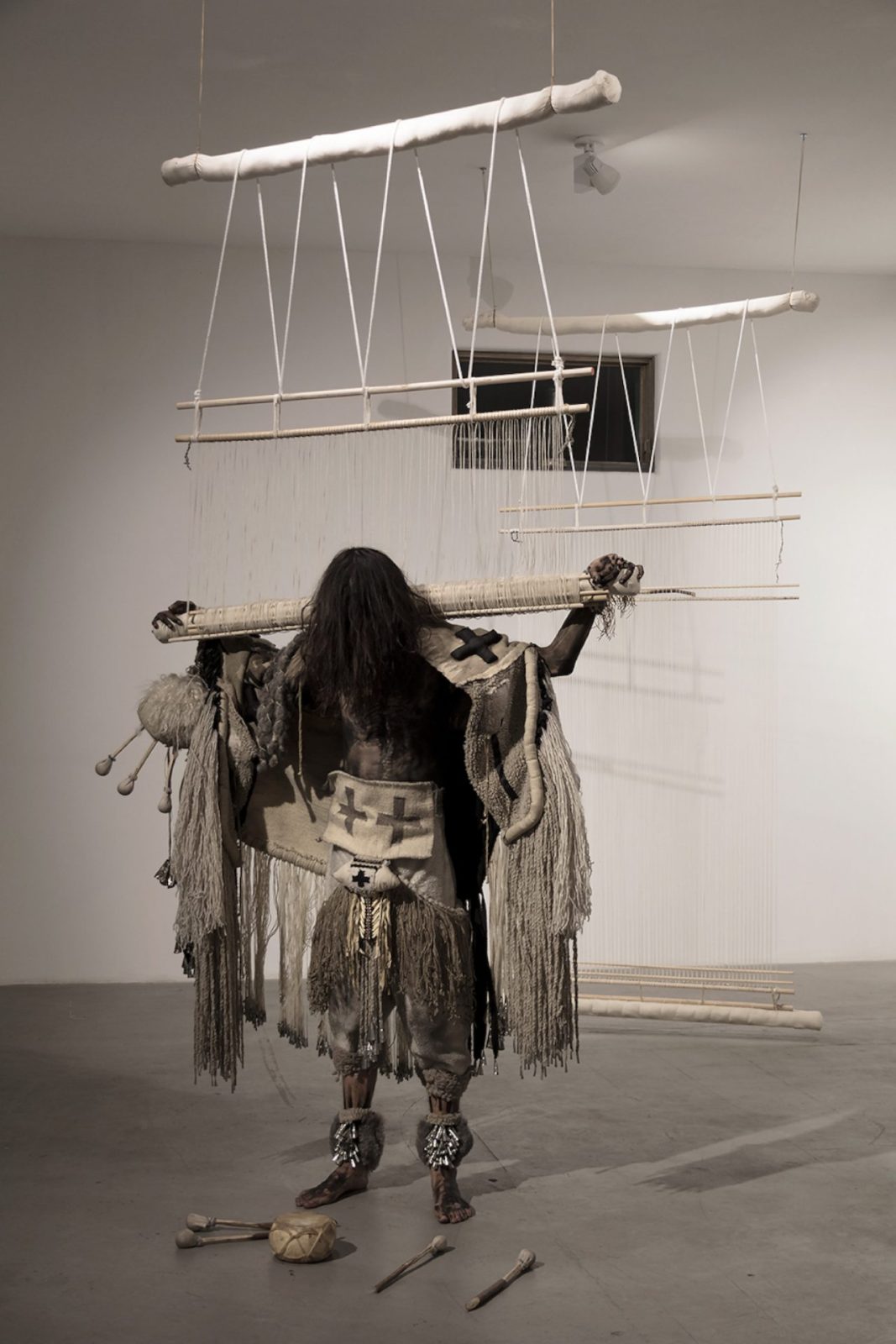
photo by Rapheal Begay, courtesy of the artist
EPR I’m also gay, so my work is inherently gay as well. I listened to a talk by Jeffrey Gibson, and he was saying something along the lines of how his work is not a monolith of just one aspect of himself, that everything that he does is encapsulated and an inherent part of the work. Being a father, being gay and Indigenous, these things are inherent within his work. They can’t be separated.
I really appreciated that and feel the same way about my work. It’s all these qualities, and so when I’m sharing it, of course that’s a part of the work, but it’s not the only thing that the work is about. I’m not going to perform in front of an audience and say, “This is a particular dance that’s in one of our sacred ceremonies.” I’m like, “No, this is my own ritual between myself and the work.” Again, from all these histories that have been passed down to me and all the knowledge that I’ve assumed over time.
PSBack to your family history, you mentioned that there was a weaver on your father’s side as well.
EPRMy father’s great-grandfather, so my paternal great-great-grandfather. And some of my father’s aunts were quilt makers and crocheters and knitters.
PSHow is Diné weaving different from using a European-style loom?
EPRWith Diné weaving, it’s… what’s the term? “Contained weaving,” I think. The entire skeleton structure is one continuous warp string, whereas in more western European modes of weaving, it’s often hundreds. At the end of those weavings you’ll see a lot of fringe, but in Diné weavings there’s no fringe. The last inch of Navajo weaving is so difficult just because the tension is so tight. It’s very time-consuming. When I took weaving classes at the University of New Mexico, I wove on a floor loom, with a bunch of pedals, and on an upright tapestry loom. They’re really fun for me, but I’ve only had experiences with those types of loom in school. The Navajo loom is really accessible in terms of what it can be made with. I’ve made looms out of PVC pipe. Basically you just need a rectangle and a couple bars and you can make a Navajo loom quickly. I like the brilliance of how my ancestors created a form that’s really accessible to materials.
PSI’m curious about those materials, which include elements like sheep’s wool and bone. What are your materials, and how do you select them?
EPRI use real leather, real hide, but then also fake cashmere or sherpa. I use a lot of different muslins. I sometimes use silks. I’ll use polyester and synthetic hair. I’ll use my own hair. I’ll use my cat’s hair and horse hair. There are so many different authentic and inauthentic materials, which I think is funny within itself—using inauthentic materials sometimes. I like that juxtaposition of having yarns of wool that I’ve washed, carded, dyed myself, directly woven with yarn from Walmart. I think it’s funny creating a regalia object where I cut up Beanie Babies and stuffed animals to have sheep heads on it. There’s definitely a level of playfulness and humor in what I do that’s perhaps not immediately apparent. It’s almost childlike in that way: the way as children we’re really attracted to soft materials, regardless of the material itself. It’s an innate thing that we grew up with, wanting stuffed animals or pillows to be surrounded by.
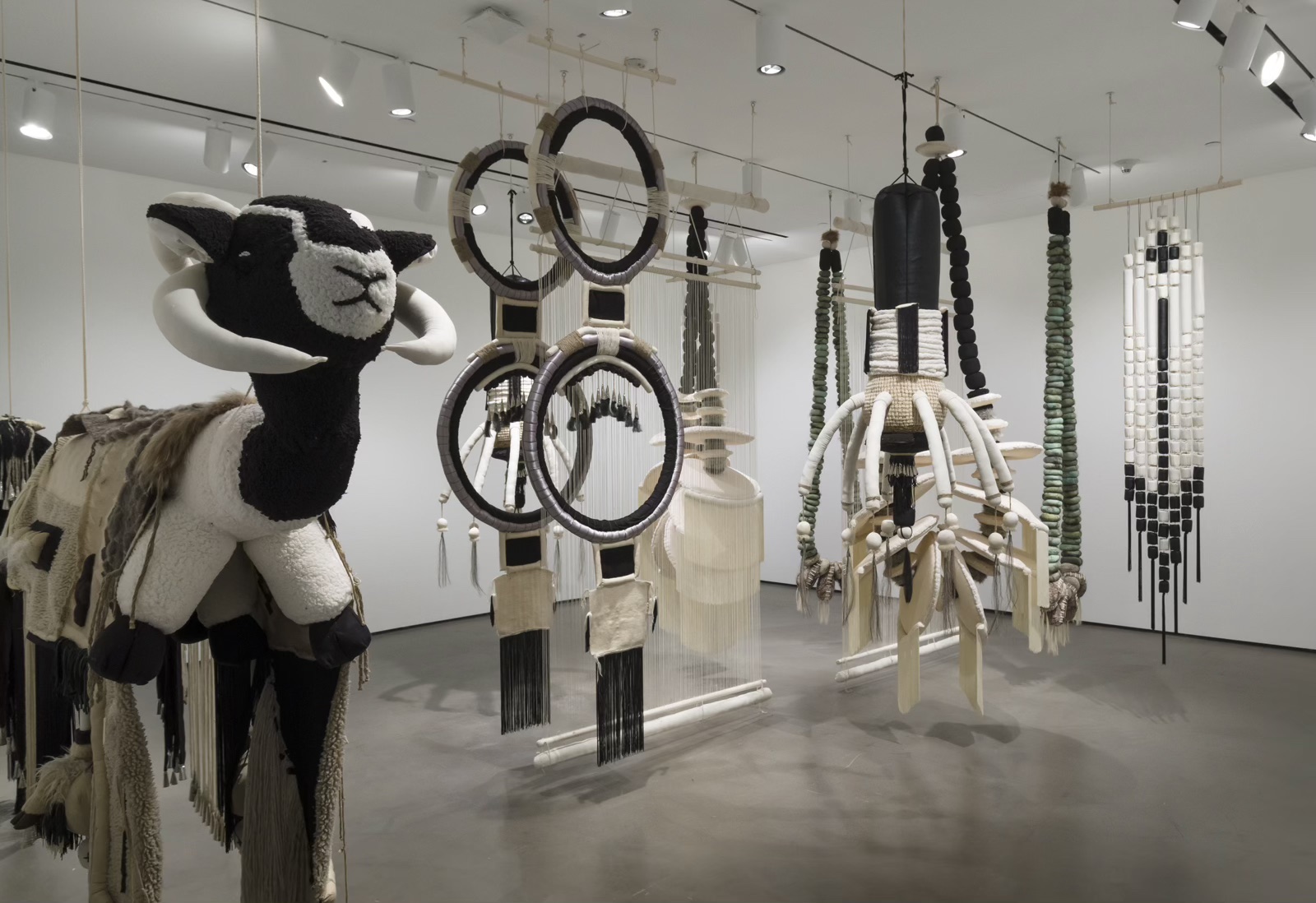
photo by Jeff McLane
I think humor’s an important part of what I do, because one of our ceremonies is called the laughing ceremony, A’wee Chi’deedloh: when a baby first laughs you throw a party for the baby. It’s like the baby’s way of saying that they want to join our world from their previous world because it’s the first time that baby is reacting to human stimulus.
All the qualities before that are qualities that every single animal has: eating, crying, yelling. These are things that all existing beings have, but laughter is something unique to humans, because you’re responding to jokes and language and expression. It’s one of our very first important ceremonies. If you make a Navajo baby laugh you have to throw a party for the baby. But it’s a double-edged sword because then you’re down a few hundred bucks throwing a party for a bunch of people.
PSBeautiful.
Going back to your materials: your palette tends to include natural colors and be very muted. There are a lot of off-whites, whites, blacks, gradients between black and gray. Is that a conscious choice or does it arise out of those materials?
EPRThe simple answer is that those are my favorite colors. But I also think it’s a respect thing, respecting what the body, ours or a sheep’s, produces. I’ve been asked before, “Are you not a colorful person? Do you not like color?” I’m like, “No, I love color. I just happen to love these colors.”
PSBefore I knew anything about you, I responded to the colors. It’s a natural vibe—bone and undyed sheep’s wool—but beyond that there’s, to me, something kind of ghostly about it. The muted quality made it almost seem like sepia tone or historical. Archeological, even.
EPRI speak about goodness a lot when I’m talking about my work, but I also think there are layers of darkness that I don’t really talk about. My biggest fear in life is loss. Again, maybe that’s why I’m a hoarder and animate everything, because I’m so afraid of losing memories and family and friends. Ghostly is a perfect term to describe that. There’s a spirit that lives within my work that I’m having conversations with. It’s a little scary to think about, but it’s also very beautiful. When you said archeological or historical, I think of the histories of what I create so often, but then again, combining the history of this real-life animal alongside a mass-produced, stuffed animal version of that animal, that makes me think about the contemporary indigeneity of a young person. Someone told me that I’m like a young millennial but an old Gen Z. I think about being a young person and how we learn about ourselves and our histories and our families and how there are so many different avenues and ways of learning. I’m luckily someone who grew up where my people are from, so I’ve had direct gifting of knowledge from family members and strangers, elders and teachers. But then I’ve also equally learned as much through avenues like the internet or academia, through television, through music, mass media, social media, memes. All of that is woven together to create one identity.
PSWe’ve talked about the softness of your work. The surfaces seem soothing in their softness. Do you think about your art in terms of healing? In terms of welcome or openness?
EPRTotally. My work has saved my life plenty of times. Welcome is an important aspect within my work. With a lot of contemporary work, there’s anger that goes into it, which I think is completely valid and important and necessary, particularly with artwork by people from many different communities. But I explore joy and laughter and fun, even as I’m going back to that ghostly idea of loss. I do want to create a place of welcome, a place of gratitude, a place of reflection and calmness and stillness. But stillness not in the sense of the work being static, but in its slowness, of the processes of weaving. I think we always need to slow down.